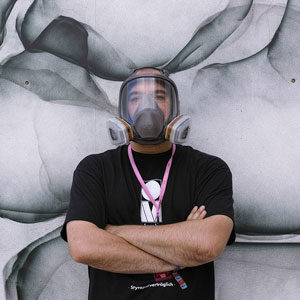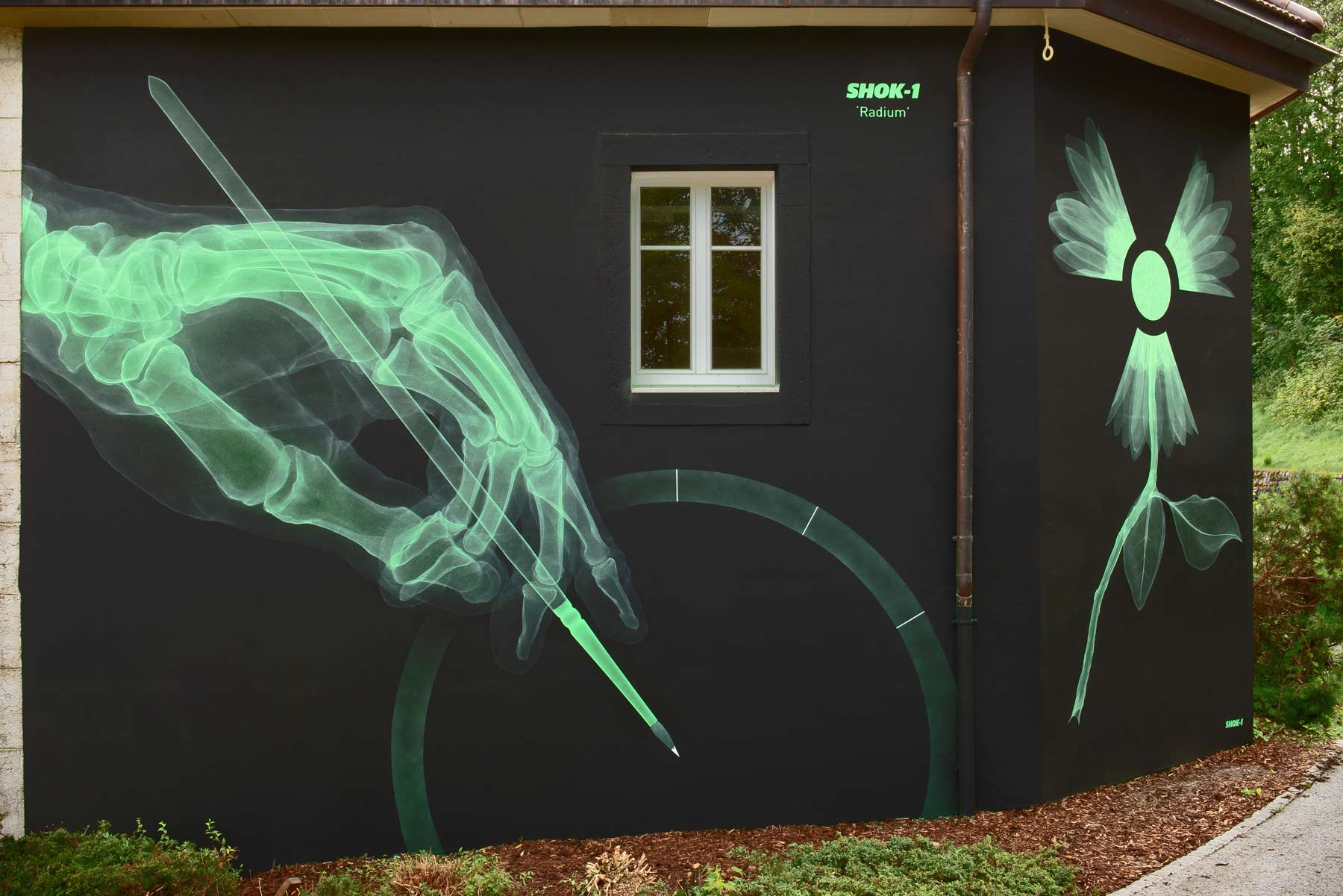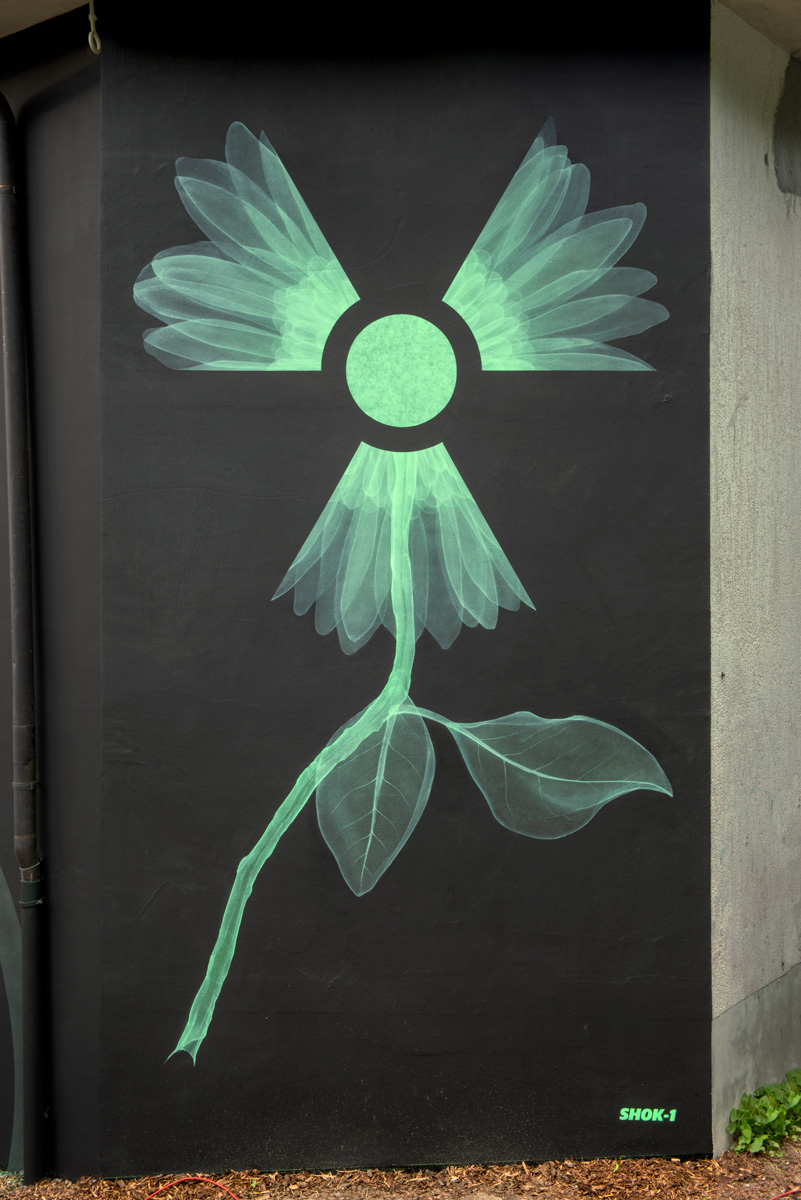Shok-1
[UK]
- THE WORK -
Radium
TITLE: Radium
Technique: FREEHAND SPRAY PAINTING
YEAR CREATED: 2021
LOCATION: Rue des Envers 63
SURFACE AREA: 50 m2
A leading light on the international street art scene, British artist SHOK-1 is a past master of the art of reproducing the sombre beauty of medical X-rays using aerosol paint. His highly skilled movement allows him to work freehand and achieve a startling level of realism, earning him the admiration of numerous scientists. His unique style, known as “X-ray art”, means the artist is cut out to pay homage to victims of radium. Used in the watchmaking industry for more than fifty years, this radioactive metal behind radiotherapy damaged the health of thousands of women who worked with radium and came to be known as the “Radium Girls”.
From a philosophical point of view, the unfortunate experiences with radium and watchmaking are a reminder of other discoveries or inventions that were initially synonymous with scientific and technological progress before being identified as causing serious harm to health or the environment.
Painted on an angled wall, SHOK-1’s mural can be viewed as a diptych. On the first part of the wall, a Radium Girl’s hand puts radioactive paint on a clock face to make it luminescent. Faithful to his pictorial style, SHOK-1 has stripped this hand of flesh to reveal its bone structure. Without a casing to give it its fullness, femininity and sensuality, this hand is turned into a cold mechanism, a robot’s hand, a pincer coming to snatch the life that seemed to be firmly attached to the body.
Since the dawn of time, skulls and skeletons have evoked death. Symbolically, X-rays prove that death lurks beneath the living. As if by discovering the interior of a Radium Girl’s hand, you could guess her tragic fate. Vitrified, this hand becomes something slightly abstract for those unable to read X-rays. Metaphorically, a large part of the mystery of life endures despite the penetrating gaze of science. While the theme being tackled is serious, SHOK-1’s mural is by no means morbid. Poetry emanates from the artist’s elegant aesthetic that transcends the sadness of our mortality. And the hand does not belong to a corpse because it is using a brush with dexterity. The movement created by the succession of superimposed transparent forms appears to bring it to life. The second part shows an upright X-ray of a flower, a metaphor for femininity. Similar to the Radium Girls, the flower’s stem has been cut by a lethal hand. Like a pathologist, SHOK-1 has dissected it to give it the silhouette of the pictogram used to denote radioactivity. These “geometric ablations” symbolise the outrages inflicted on the Radium Girls and the terrible harm they suffered.
On a chromatic level, SHOK-1 has strived to use a palette of colours to faithfully reproduce the greenish light of radium. The artist has put his composition on a black background because radium enabled people to read the time in the dark. Topologically, the bushes around this mural reinforce the sense of being at a memorial.
From a philosophical point of view, the unfortunate experiences with radium and watchmaking are a reminder of other discoveries or inventions that were initially synonymous with scientific and technological progress before being identified as causing serious harm to health or the environment.
Painted on an angled wall, SHOK-1’s mural can be viewed as a diptych. On the first part of the wall, a Radium Girl’s hand puts radioactive paint on a clock face to make it luminescent. Faithful to his pictorial style, SHOK-1 has stripped this hand of flesh to reveal its bone structure. Without a casing to give it its fullness, femininity and sensuality, this hand is turned into a cold mechanism, a robot’s hand, a pincer coming to snatch the life that seemed to be firmly attached to the body.
Since the dawn of time, skulls and skeletons have evoked death. Symbolically, X-rays prove that death lurks beneath the living. As if by discovering the interior of a Radium Girl’s hand, you could guess her tragic fate. Vitrified, this hand becomes something slightly abstract for those unable to read X-rays. Metaphorically, a large part of the mystery of life endures despite the penetrating gaze of science. While the theme being tackled is serious, SHOK-1’s mural is by no means morbid. Poetry emanates from the artist’s elegant aesthetic that transcends the sadness of our mortality. And the hand does not belong to a corpse because it is using a brush with dexterity. The movement created by the succession of superimposed transparent forms appears to bring it to life. The second part shows an upright X-ray of a flower, a metaphor for femininity. Similar to the Radium Girls, the flower’s stem has been cut by a lethal hand. Like a pathologist, SHOK-1 has dissected it to give it the silhouette of the pictogram used to denote radioactivity. These “geometric ablations” symbolise the outrages inflicted on the Radium Girls and the terrible harm they suffered.
On a chromatic level, SHOK-1 has strived to use a palette of colours to faithfully reproduce the greenish light of radium. The artist has put his composition on a black background because radium enabled people to read the time in the dark. Topologically, the bushes around this mural reinforce the sense of being at a memorial.
© exomusée – January 2022 – Redaction: François Balmer – Translation: Proverb, Heiler & Co
BRIEF HISTORY OF RADIUM
Radium is a highly radioactive metal that was discovered in 1898 by Marie Curie and her husband Pierre and attracted keen interest in the early 20th century. For decades, it was used in devices for emergency signalling, lightning conductors and smoke detectors. Glorified for its supposed therapeutic benefits, it was added to rejuvenating creams, cigarettes, “atomic” fizzy drinks, toothpaste, bath salts and baby talcum powder. Radium drinking fountains were even invented to make water radioactive.
Watchmaking companies also thought it would be a good idea to benefit from an unusual feature of radium: its radioluminescence. Between 1918 and 1963, the industry employed thousands of women as a cheap, flexible and meticulous workforce. The work of these “Radium Girls” consisted of putting a fine layer of radium paint on the hands and indices so that the dial could be read in the dark. This was done by the workers with fine brushes that they shaped into a point with their lips and tongues to achieve the desired precision, thus ingesting small quantities of radium. The chronic radiation to which they were exposed during their lifetime exceeded the lethal amount received by victims of the atomic bomb dropped on Hiroshima. The directors and senior executives of the watch companies were well aware of the dangers posed by this material, but no one told the workers. The lethal paint made in the factory was presented to them as completely harmless, so much so that they used it at home to make light switches fluorescent, prettify dolls’ hair and paint stars on the ceilings of children’s bedrooms, even going so far as to paint their nails, teeth and faces with it to amuse other people.
Since the largest watch factories in the 20th century were in the United States, logically this is where most of the victims were. Sick Radium Girls had to fight a long and exhausting legal battle to receive compensation. When financial interests are at stake, proving the link between a professional activity and a pathology is always difficult (a striking example being the asbestos scandal). However, this causality was scientifically proven with the Radium Girls, with “radium jaw” recognised as an occupational disease. In the United States, the “Radium Girls” case has an important place in the history of the employee rights movement and healthcare.
In the industrial town of Le Locle, which is the birthplace of watchmaking, radium has also left its mark. Until the 1960s, people’s flats were contaminated with this poison because working at home was widespread in the watchmaking industry. When the dangers of radium were revealed to the public, the Radium Girls gave up their brushes and switched to fine glass tubes.
Radium was eventually banned in 1963. It was succeeded by tritium, which is slightly radioactive but not thought to be harmful to health. From 1993, Swiss watchmaking favoured LumiNova, a phosphorescent paint made using non-toxic and non-radioactive strontium aluminate. Even more luminescent, Super-LumiNova was invented in 2007.
There are no statistics about the number of radium victims in Switzerland. Between 2015 and 2019, the Swiss Confederation funded a clean-up and decontamination campaign for all buildings affected by this type of pollution, which has now been extended to 2022.
Watchmaking companies also thought it would be a good idea to benefit from an unusual feature of radium: its radioluminescence. Between 1918 and 1963, the industry employed thousands of women as a cheap, flexible and meticulous workforce. The work of these “Radium Girls” consisted of putting a fine layer of radium paint on the hands and indices so that the dial could be read in the dark. This was done by the workers with fine brushes that they shaped into a point with their lips and tongues to achieve the desired precision, thus ingesting small quantities of radium. The chronic radiation to which they were exposed during their lifetime exceeded the lethal amount received by victims of the atomic bomb dropped on Hiroshima. The directors and senior executives of the watch companies were well aware of the dangers posed by this material, but no one told the workers. The lethal paint made in the factory was presented to them as completely harmless, so much so that they used it at home to make light switches fluorescent, prettify dolls’ hair and paint stars on the ceilings of children’s bedrooms, even going so far as to paint their nails, teeth and faces with it to amuse other people.
Since the largest watch factories in the 20th century were in the United States, logically this is where most of the victims were. Sick Radium Girls had to fight a long and exhausting legal battle to receive compensation. When financial interests are at stake, proving the link between a professional activity and a pathology is always difficult (a striking example being the asbestos scandal). However, this causality was scientifically proven with the Radium Girls, with “radium jaw” recognised as an occupational disease. In the United States, the “Radium Girls” case has an important place in the history of the employee rights movement and healthcare.
In the industrial town of Le Locle, which is the birthplace of watchmaking, radium has also left its mark. Until the 1960s, people’s flats were contaminated with this poison because working at home was widespread in the watchmaking industry. When the dangers of radium were revealed to the public, the Radium Girls gave up their brushes and switched to fine glass tubes.
Radium was eventually banned in 1963. It was succeeded by tritium, which is slightly radioactive but not thought to be harmful to health. From 1993, Swiss watchmaking favoured LumiNova, a phosphorescent paint made using non-toxic and non-radioactive strontium aluminate. Even more luminescent, Super-LumiNova was invented in 2007.
There are no statistics about the number of radium victims in Switzerland. Between 2015 and 2019, the Swiss Confederation funded a clean-up and decontamination campaign for all buildings affected by this type of pollution, which has now been extended to 2022.
© exomusée – January 2022 – Redaction: François Balmer – Translation: Proverb, Heiler & Co
Rue des Envers 63
- THE ARTIST -
SHOK-1

“A pioneer of aerosol paint X-ray art since 1984.” This is how SHOK-1 defines himself as a street artist. Born in the United Kingdom in 1970, this icon of street art started spray painting in the streets when he was thirteen and is entirely self-taught. SHOK-1 was among the first Europeans to help make street art one of the most important artistic movements worldwide.
Heavily influenced by graffiti and more widely by the street culture that exploded in the US In the early 1980s, SHOK-1 tried his hand at various painting techniques. From 1989, the artist produced works abroad, particularly on his travels around the US and China. In 2009, he developed a unique technique to depict X-rayed bodies. His new style “X-Ray” created a sensation and his career really took off.
By building a bridge between science and street art, SHOK-1 appeals to a broad public: from fans of pop culture, contemporary art and street art to surgeons, radiologists and scientists. The artist strives to depict the human skeleton as faithfully as possible because anatomical accuracy takes on particular importance for fans from the world of medicine. On social networks, this large group of experts is just waiting for the tiniest morphological anomaly, providing SHOK-1 with ample motivation to keep demonstrating his scientific rigour. To achieve this, over the years the artist has compiled a huge collection of X-rays. Pro-science, SHOK-1 aims to champion rationalism in an era where, in his words, “’anti-intellectualism is on the rise, scientists are silenced and experts are denounced in favour of the layman’s opinion”. SHOK-1’s fascination with science is not unconnected to his interest in medical X-rays. “If an X-ray can give good or bad news, it’s synonymous with the truth. And if the truth is crucial from the perspective of medicine, then it generally is for society too,” says the artist.
SHOK-1’s art reveals what the naked eye cannot see. By X-raying contemporary objects such as toys, the artist challenges materialistic and consumerist values. Symbolically, this research is like a diagnosis of life in the 21st century. His paintings inspired by X-rays of flowers reveal the delicate beauty of nature from a new perspective. By replacing the stem of flowers with barbed wire, SHOK-1 evokes man’s propensity to pervert beauty, purity and harmony.
A perfectionist, SHOK-1 likes to collect information about the themes he tackles. From a pure idea to numerous sketches by way of the analysis of dozens of X-rays, his works are the result of a lengthy creative process.
Based in London, SHOK-1 has a degree in applied chemistry.
Heavily influenced by graffiti and more widely by the street culture that exploded in the US In the early 1980s, SHOK-1 tried his hand at various painting techniques. From 1989, the artist produced works abroad, particularly on his travels around the US and China. In 2009, he developed a unique technique to depict X-rayed bodies. His new style “X-Ray” created a sensation and his career really took off.
By building a bridge between science and street art, SHOK-1 appeals to a broad public: from fans of pop culture, contemporary art and street art to surgeons, radiologists and scientists. The artist strives to depict the human skeleton as faithfully as possible because anatomical accuracy takes on particular importance for fans from the world of medicine. On social networks, this large group of experts is just waiting for the tiniest morphological anomaly, providing SHOK-1 with ample motivation to keep demonstrating his scientific rigour. To achieve this, over the years the artist has compiled a huge collection of X-rays. Pro-science, SHOK-1 aims to champion rationalism in an era where, in his words, “’anti-intellectualism is on the rise, scientists are silenced and experts are denounced in favour of the layman’s opinion”. SHOK-1’s fascination with science is not unconnected to his interest in medical X-rays. “If an X-ray can give good or bad news, it’s synonymous with the truth. And if the truth is crucial from the perspective of medicine, then it generally is for society too,” says the artist.
SHOK-1’s art reveals what the naked eye cannot see. By X-raying contemporary objects such as toys, the artist challenges materialistic and consumerist values. Symbolically, this research is like a diagnosis of life in the 21st century. His paintings inspired by X-rays of flowers reveal the delicate beauty of nature from a new perspective. By replacing the stem of flowers with barbed wire, SHOK-1 evokes man’s propensity to pervert beauty, purity and harmony.
A perfectionist, SHOK-1 likes to collect information about the themes he tackles. From a pure idea to numerous sketches by way of the analysis of dozens of X-rays, his works are the result of a lengthy creative process.
Based in London, SHOK-1 has a degree in applied chemistry.
© exomusée – January 2022 – Redaction: François Balmer – Translation: Proverb, Heiler & Co
To print the content of the page, please click on the printer icon.
- The exo -
on the web
Thank you for following and supporting the exomusée on Facebook, Instagram and YouTube!





